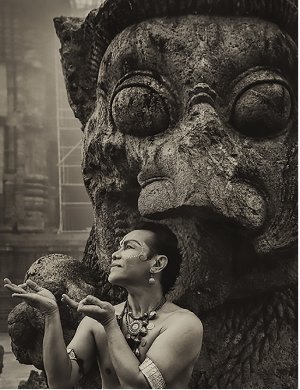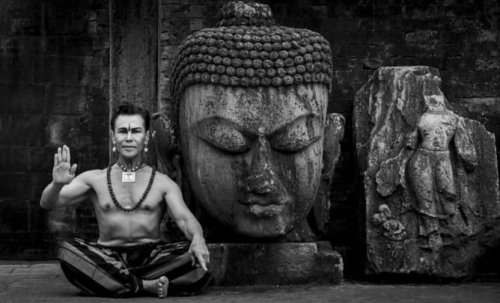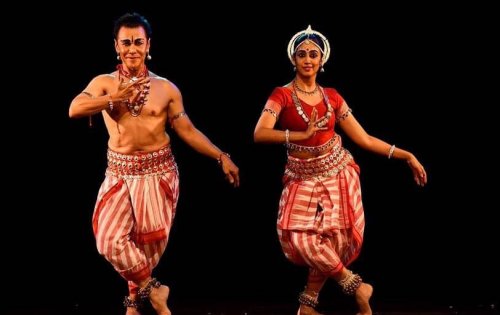
|
 |

|
 |
I can weave through many interesting identities and roles: Ramli Ibrahim - Vijay Shanker e-mail: shankercsn@gmail.com May 13, 2019  Acclaimed as a brilliant Odissi exponent and contemporary western choreographer, credited for his flamboyant and aesthetic performances, Malaysia's 'Datuk' Ramli Ibrahim commenced his career as a dancer with Western Australian Dance Company and later established Sutra Foundation (2007) in Malaysia with a team of talented dancers, travelling all over the world with spectacular performances. In an exclusive interview, Ramli talks about his India tour, his career that spans more than four decades, how he placed Odissi on the world map and much more. How and when were you initiated into dance? I realized quite early in my childhood that I have a strong artistic temperament. As a child I was attracted to beautiful things and used to take to music, dance, drama, painting and even cooking, easily. I have a natural affinity to nature and since young I love animals and plants. I used to dance and sing for my mother's guests and some who are still alive remember me as this kid who would perform for them at the drop of a hat. My cousins and other kids of the same age used to hide in embarrassment. They couldn't bear watching me make a complete exhibitionist of myself. For a few years, when I was still in my primary schooling, I had a major role as a compere and singer in a radio series especially designed for children. Somehow, deep in my heart and soul, I knew that eventually I would find myself in the Arts field. Dance saved me when I was in Australia studying for matriculation and degree (Engineering). Australia had a more liberal and conducive environment and I was able to submit myself to a proper and rigorous dance training. Fortunately, I had the right physique and temperament for dance and my development was rapid. Soon I was dancing for the Western Australian Dance Company and in other professional productions, in my spare time. The interest in Indian classical dance came about soon as I consolidated my own bearing with regard to my own involvement and quest for answers for my reason of being. I delved into philosophy, comparative religion and myths, especially Asian myths. Though known now as an Indian classical dancer, I still regard myself also as a contemporary modern choreographer and dancer. What fascinates you the most about Odissi? Both the body dynamics and music attracted me in the first place. Fortunately, Odissi does not suffer, like Bharatanatyam, from the rigidity, predictability and tyranny of the adavu system. It is still able to surprise one with authentic new moves, which are still part of the aesthetic of the Odiyan dance tradition. In a good Odissi dance, one finds a balance of the Apollonian (symmetry, order) and Dionysian (asymmetrical, abandonment) principles which makes it visually appealing. The music, at its best, is able to soar to great heights. It is less intellectual. The combination of music and dance can lift one's spirit to abandoned heights. What has been the reaction of your family towards your passion for dance? As far as education goes, my parents could not complain of my results. My parents hardly had to pay for my education as I had sailed through my education winning many scholarships. From the onset, I made it known to everyone that I should take charge of my own life. My artistic penchant was recognized since young. However, my parents never encouraged nor sent me to art or music school though I was obviously inclined in that direction. Later, when I started to be seriously involved in dance, my parents did not discourage me either. So, they kind of left me alone... Hailing from a Muslim community, was it difficult for you to become a professional Indian classical dancer? Yes, I have always known it would be a difficult life as a professional Indian classical dancer. Period. Let alone being a male dancer and on top of that, a Muslim. But when I was young, I never thought of the obstacles and trusted absolutely in my talent. I often thought how privileged I was to be able to dance. I had walked naively through the mine field so to speak, without ever realizing that it was strewn with danger. There was a inherent trust that the universe will take care of me and all I need to do is my 'sadhana' on my art. Can you describe your growing up years in Malaysia? I was born in Kajang, a sleepy town on the fringe of Kuala Lumpur, the youngest of six children. My father, who was in the teaching profession, soon went to another town in another state, where I spent my early childhood. I had a normal Muslim upbringing and my parents were considered devout Muslims, but not too strict. My siblings and I had a thorough grounding in our religious education. Malaysia has always been a multi-racial country with idyllic and diverse multi-cultural milieu. The scenario was much more tolerant than it is today as the Wahhabis had not made their proselytizing entrée into the system. I had a great growing up period.  What is the cultural scenario in Malaysia; does the Government promote classical artistes? The present cultural scenario in Malaysia is not so conducive to culture, though culture is still vibrant in Malaysia. Presently, the artistic and cultural activities have been mainly supported by the artistes themselves and sustained by a few enlightened individuals. As yet, the new government has not been able to clean its act where the Arts and Culture Ministry goes. They are merely patching up the same scenario from the previous government whereas I think there should be a complete make-over. The same arts lacklustre bureaucrats, the same cultural brokers are actually still running the show. Therefore, the previous government's dated cultural infrastructure still holds sway and the same machinery still plods on. The old National Cultural Policy, stilted to make the Malays even more regressive than they already are coupled with austere Islamic notions of Arabization, still forms the guide for Arts and Culture policies. The policy makers still pander to the conservatives who are not sufficiently enlightened to the kind of liberal arts which will unshackle the population from mediocrity and backwardness. The provisions of the archaic National Cultural Policy still represent the guide to the notions of what constitute Arts and Culture in the country and how to run the business of Arts and Culture. If even Malay culture, the most funded of all the group, is suffering, what about Indian, Chinese or other ethnic cultures, including indigenous (adivasi) traditions. One finds Indian and Chinese dancers charting their own narratives and funding their own productions and these may turn out to be their saving grace. Sutra is an oasis amidst all this rather bleak scenario. It's a miracle that we are able to survive and thrive in the midst of such an infrastructure and poorly managed arts and culture. Tell us about Sutra Foundation and what were the problems faced in order to establish Odissi in Malaysia? Sutra has been consistently creative over many years. However, it was only in 2007 that we were able to establish the Foundation to consolidate our activities and also make sure that Sutra's objectives and legacy can be sustained somewhat for the future. Through the Foundation we are able to continue to be active in engaging the community to be part of nation building through our activities. The main problem is seeking funds to continue our activities and to be more sustainable and effective where activities in arts and culture are concerned. There is a vital need to strengthen our base with the youths and we are now concentrating on our Dance Outreach Programs. We need funds to engage effectively with the community and this is part of an ongoing and never ending challenge. Your program is titled 'Odissi on High'; please throw some light on the highness of Odissi. The 'highness' we allude to not only comes from the verve and energy of the dancers; not only from the audacity of new ideas; or the technical demand of the work but also from the excellence and prowess of the dancers. Most of all, the highness comes from the thought and content behind the concept. Does marriage hinder the progress of artistes? Your comments... Generally speaking, marriage tends to distract artistes from their calling. The creative muse is a jealous and protective spirit-guide of an artiste. She demands the fullest attention and does not contend with anyone or anything which will distract the artiste from her call. She leaves you before you even think of leaving her. And when muse does leave him, the artiste loses the sense of destiny which is special for him. Your most memorable performance? I have many memorable performances but I seldom dwell on specifics. Usually, I am just so thankful that a performance survives. Murphy's Law (if there is anything that can go wrong, for sure it will go wrong) applies during a performance. For instance, at this very moment of writing, there is a raging cyclone outside and we are not sure if we will be able to present our first performance of Odissi on High in Bhubaneswar, for the India tour.  Which role of yours is most important - dancer, teacher or choreographer? I think the choreographer is the most rare of the three. The choreographer is the creator - he creates something, which did not exist before. This is a gift of the highest order. Next come the teacher, who has to be an extraordinarily generous artiste who places another as the subject of his/her efforts - to cultivate and groom a latent talent and make an artiste out of the budding dancer. The last is the dancer, interprets what the choreographer and teacher have gifted him. The dancer generally gets all the accolades. Tell us about your prestigious title 'Datuk'? The Datuk is just an honorific title, conferred by the head of state in Malaysia to an individual who is deemed deserving for his or her contribution in his or her field of expertise. It is not unlike the 'Padma Shri'. My 'Datuk' was a 'Federal' Datukship, conferred by the King of Malaysia. Any unusual incident or experience in your life? Nothing terribly unusual happens in my life, though I am very much a voyeur of the life of others. I find theirs most unusual and I am absolutely fascinated by the life of others. Most of all, I am fascinated by the lives of my pets and find myself observing their gestures, reactions and expressions to the minutest detail. I am also an observer of the plant life. Are you happy as an Odissi exponent? Your future aspirations? I think I am very satisfied with my life, as I have given the best I can. However, though Odissi is an important part of my life, it is not the only thing I do. In fact, I revel functioning within many identities and consider myself lucky that I can weave through so many interesting identities and roles - negotiating through modern and traditional sensibilities and being completely at ease with the cultural bio-diversity which is available on my plate. Contact Ramli Ibrahim: sutrafoundation25@gmail.com Post your comments Unless you wish to remain anonymous, please provide your name and email id when you use the Anonymous profile in the blog to post a comment. All appropriate comments posted with name & email id in the blog will also be featured in the site. |